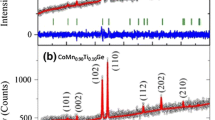Conclusions
-
1.
In magnico alloys carbon favors the development of the high-temperature β2→α+β2-decomposition and this decomposition has a negative effect on the magnetic properties of the alloys.
-
2.
The magnico alloys can be characterized by the hardenability, which is understood as the diameter of a cylindrical magnet ensuring the absence of the β2→α+β2-transformation after quenching. The hardenability of the magnico alloys increases with decreasing carbon concentrations.
-
3.
We obtained good magnetic properties in magnets of small cross section containing up to 0.05% C.
Similar content being viewed by others
Literature Cited
Ya. M. Dovgalevskii and N. I. Mikheev, "Izvestiya vysshikh uchebnykh zavedenii", Chernaya metallurgiya, No. 11 (1964).
E. G. Povolotskii and Ya. M. Dovgalevskii, Collection of Reports of the All-Union Meeting on Cast Alloys for Permanent Magnets [in Russian], Saratov (1964).
B. G. Livshits and V. S. L'vov, High-Coercive-Force Alloys [in Russian]. Moscow, Metallurgizdat (1960).
Author information
Authors and Affiliations
Additional information
Translated from Metallovedenie i Termicheskaya Obrabotka Metallov, No. 6, pp. 33–36, June, 1966
Rights and permissions
About this article
Cite this article
Mikheev, N.I., Dovgalevskii, Y.M. & Povolotskii, E.G. Influence of carbon in magnico alloys. Met Sci Heat Treat 8, 468–470 (1966). https://doi.org/10.1007/BF00658935
Issue Date:
DOI: https://doi.org/10.1007/BF00658935



